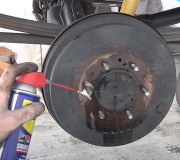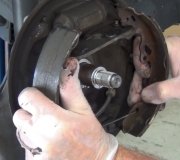Do you have enough money to fix the car or person you hit? It's nice to spend money to make it go, but it's more important to spend whatever is necessary to make it stop. First check the steel brake lines and rubber flex hoses for signs of a leak. Next, check inside the brake backing plates for wetness. If you see any brake fluid running out onto the inside of a tire, inspect that wheel cylinder. We used to rebuild them at every brake job, but today those wheel cylinders cost about the same as the kits to rebuild them, and you get a warranty. A new wheel cylinder used to cost around ten bucks, and the kits were typically about half of that. The advantage of the kits is you don't have to unbolt the wheel cylinder or risk twisting off a rusted line. The disadvantage is you have to take the time to hone the old cylinder to remove stuck-on debris, then you have to wash it out with brake parts cleaner. You 'll spend more money on chemicals and tools than for the parts. The shoes will need to be replaced too if they are contaminated with brake fluid.
Brake fluid leaking from a front wheel cylinder can cause a pull two ways. Most commonly the fluid on the drums and linings changes the carefully-designed-in coefficient of friction so the two brakes have unequal stopping power. On newer front-wheel-drive cars a loss of fluid pressure to one front brake can cause a slight wobble in the steering wheel when hitting the brakes due to a decrease in fluid pressure. Your car still uses a single master cylinder so there would be a loss of fluid pressure equally at all four wheels.
Misadjustment of the brakes can cause a pull too when the shoes contact the drums at different times as the pedal is pressed, but that would not cause a loss of brake fluid.
SPONSORED LINKS
Monday, November 26th, 2012 AT 8:02 PM




